The Führer’s Battle in the East 2
Background: This one of numerous small booklets given to those who contributed to the Nazi Party’s Winter Relief charity. There was one for each of the years 1933-1939, for various campaigns of the war, for soldiers who had won the Iron Cross, and more that I have not yet seen. This one is the second in a series on the Polish campaign, produced I think in late 1939. It traces the events of the campaign that destroyed Poland. The photos are the actual size. They were taken by Heinrich Hoffmann, Hitler’s personal photographer.

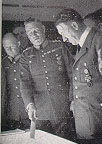
Caption: 1 September. The Führer and General Keitel
Text: “At the command of the Führer and Supreme Commander, the Wehrmacht took up the defense of the Reich. In accordance with their orders to resist Polish aggression, German troops crossed the German border to counterattack. Luftwaffe squadrons simultaneously attacked military targets in Poland.”
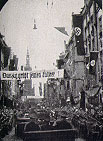
Caption: Jubilation in liberated Danzig
Text: “The navy took up station in the Baltic Sea.
Gauleiter Forster reported to the Führer that Danzig had returned to the Reich. The free city was now part of the German Reich.
The Führer replied: ‘Greater Germany greets you with overflowing hearts. The law on reunification goes into effect immediately’”
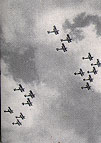
Caption: 2 September. The Luftwaffe attacks.
Text: “German troops achieved quick successes on every front. The German Luftwaffe carried out lightning-fast, devastating strikes against military targets in Poland. Numerous Polish aircraft were destroyed. Numerous military airfields were attacked. The planes in the hangars or on the field went up in flames.”
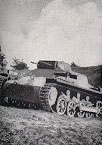
Caption: 3 September. Tanks roll.
Text: “Tschenstochau was overrun. The Warte River was crossed east of Wielun. After its decisive attacks on 2 September, the German air force totally dominated the air over Poland and was ready for further attacks.”
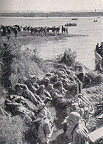
Caption: 4 September. Crossing the Weichsel River
Text: “The Weichsel crossing was contested east of Pleß. Pommeranian forces reached the Weichsel near Kulm. That cut off the Polish forces in the northern part of the corridor. German forces were attacking the fortress at Graudenz. Increased attacks by the Luftwaffe contributed to the rapid successes.”

Caption: 5 September. The Führer’s car heads to the front
Text: “The German forces break through enemy resistance everywhere and continue pressing onward. The encircled Polish corridor army to the north makes desperate attempts to break out. The Graudenz fortifications are captured. The Führer watches troops cross the Weichsel near Kulm. After a hard battle, Mlawa is captured.”
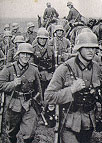
Caption: 6 September. On a Polish road
Text: “Army Group South has thrown the Poles back to Krakow. The Upper Silesian industrial area is in German hands. The German forces that crossed the Weichsel near Kulm and Graudenz are pursuing the enemy. The enemy withdraws to the south from Mlawa. Rapidly moving troops have reached the Narew River near Rozan. 10,000 men and 60 heavy weapons have been captured in the north.”
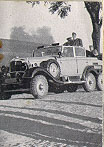
Caption: 7 September. The Führer is coming.
Text: “The Poles are retreating everywhere, with the Germans at their heels. Neu-Sandez is captured in the south. Krakow is captured without resistance. Military honors are given at Marshall Pilsudski’s grave. The Tuchel Heath to the north is cleared up and the remaining Polish forces escaping across the Weichsel. Bombs have set Warsaw’s West Train Station in flames.”

Caption: 8 September. In liberated Lodz
Text: “Mobile forces reach the mid-Weichsel and approach the southwestern suburbs of Warsaw. Other forces are nearing Lublin. The troops at Lodsch head south to the Bzura River to attack the weakening enemy.”

Caption: 9 September. Polish prisoners of war
Text: “The province of Posen is occupied without enemy resistance. At the Weichsel’s bend between Sandomir and Kutno, motorized and tank units have had great successes. Elements of numerous Polish divisions have been surrounded near Radom, and are being attacked from all sides. Northwest of Warsaw, troops have reached the south bank of the Bug River.”

Caption: 10 September. The Führer at the Front
Text: “The great battle in Poland is nearing its height: the destruction of the Polish army west of the Weichsel. Polish forces in the East of Warsaw have opened fire with guns of every caliber on our forces in the city’s west. The Polish military harbor at Gdingen is nearly surrounded. Neustadt and Putzig are in German hands.”

Caption: 11 September. A destroyed railway station
Text: “In the provinces of East Prussia, Posen, and West Prussia, our troops have occupied numerous cities, including Posen, Thorn, Gnesen, and Hohensalza. Here, too, former German land is again firmly in German hands. The West Train Station in Lemberg is destroyed, as is the station in Bialystok.”

Caption: 12 September. The Führer watches the crossing of the San River.
Text: “West of the Weichsel, the great battle is nearing its end. To the south, troops are crossing the San River. Between Radom and Lyla Gora, the enemy abandons his weapons. The weapons and supplies of at least four divisions are about to be captured. The number of prisoners is still uncertain. “

Caption: Captured Poles in a POW camp
Desperate attempts by the surrounded Polish troops near Kutno to escape to the south are beaten back. The ring around them is unbreakable. North of the Weichsel, our forces are nearing the fortress at Modlin. Luftwaffe units are supporting our troops at Kutno and attacking retreating enemy units to the east of the Weichsel. Dive bombers have sealed off the eastern approaches to Warsaw.”

Caption: 13 September. Hitler and Göring at headquarters
Text: “The north and south wings of the army are pursuing the enemy.
The surrounded Polish units south of Radom have ceased to exist. We capture enormous quantities of soldiers, weapons and supplies. All attempts by five Polish divisions and two cavalry regiments near Kutno to break out fail.”

Caption: 14 September. A captured Polish field battery
Text: “Preliminary reports are that 600,000 prisoners, including many generals, have been captured at Radom, along with 143 heavy guns and 38 tanks. The attack on the divisions surrounded near Kutno continues.
The 18th Polish Division, including the division staff, abandon their weapons to the north of Ostrow. We take 6,000 prisoners and 30 big guns.”



